
The Great Western Railway (GWR) was a British railway company that linked London with the southwest, west and West Midlands of England and most of Wales. It was founded in 1833, received its enabling act of Parliament on 31 August 1835 and ran its first trains in 1838 with the initial route completed between London and Bristol in 1841. It was engineered by Isambard Kingdom Brunel, who chose a broad gauge of 7 ft —later slightly widened to 7 ft 1⁄4 in —but, from 1854, a series of amalgamations saw it also operate 4 ft 8+1⁄2 in standard-gauge trains; the last broad-gauge services were operated in 1892.

The 4073 or Castle Class are 4-6-0 steam locomotives of the Great Western Railway, built between 1923 and 1950. They were designed by the railway's Chief Mechanical Engineer, Charles Collett, for working the company's express passenger trains. They could reach speeds of up to 100 mph (160 km/h).

Great Western Railway (GWR) is a British train operating company owned by FirstGroup that operates the Greater Western passenger railway franchise. It manages 197 stations and its trains call at over 270. GWR operates long-distance inter-city services along the Great Western Main Line to and from the West of England and South Wales, inter-city services from London to the West Country via the Reading–Taunton line, and the Night Riviera sleeper service between London and Penzance. It provides outer-suburban services in West London; commuter services from its London terminus at Paddington to the Thames Valley region, including parts of Berkshire and Buckinghamshire, and Oxfordshire; and regional services throughout the West of England and South Wales to the South coast of England. Great Western Railway provides and maintains the Electrostar Class 387 fleet for Heathrow Express.

The Dartmouth Steam Railway, formerly known as the Paignton and Dartmouth Steam Railway, is a 6.7-mile (10.8 km) heritage railway on the former Great Western Railway branch line between Paignton and Kingswear in Devon, England. Much of the railway's business is from summer tourists from the resorts of Torbay, who travel to Kingswear, where the Dartmouth Passenger Ferry takes them across the River Dart to Dartmouth.

5051 Drysllwyn Castle is a Great Western Railway (GWR) Castle Class locomotive built at Swindon Works in May 1936 and named after Dryslwyn Castle. It is owned by the Didcot Railway Centre.

GWR 4073 "Castle" Class No. 4079 Pendennis Castle is a 4-6-0 steam locomotive built in 1924 for the Great Western Railway (GWR) at Swindon Works to a design of Charles Collett. It was employed on long-distance express passenger trains on the GWR and its successor, British Railways' Western Region.
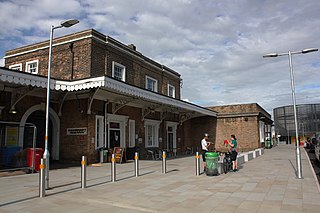
Taunton railway station is a junction station on the route from London to Penzance, 163 miles 12 chains (263 km) west of London Paddington station, measured via Box. It is situated in Taunton, Somerset, and is operated by Great Western Railway. The station is also served by CrossCountry trains and by the West Somerset Railway on special event days and by mainline steam excursions.
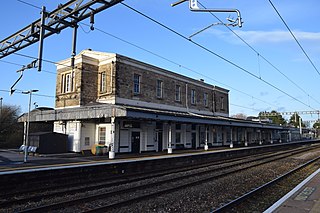
Swindon railway station is on the Great Western Main Line in South West England, serving the town of Swindon, Wiltshire. The station is 77 miles 23 chains down the line from the zero point at London Paddington and lies between Didcot Parkway and Chippenham. It is managed by Great Western Railway, which also operates all of the services from the station. It is the busiest station in Wiltshire, and the fifth busiest station in South West England.
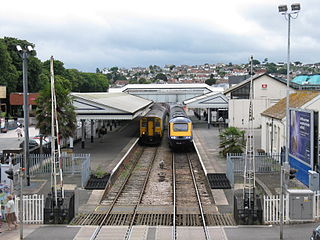
Paignton railway station serves the town and seaside resort of Paignton in Devon, England. It is 222 miles 12 chains (358 km) from London Paddington, via Box. It opened in 1859 and is now the terminus of Riviera Line services from Exeter and heritage services on the Dartmouth Steam Railway from Kingswear.

Torquay railway station is on the Riviera Line and serves the seaside resort of Torquay, Devon, England. It is 219 miles 79 chains (354 km) from London Paddington.

Torre railway station is a suburban station on the Riviera Line in Torquay, Devon, England. It is 219 miles 12 chains (353 km) measured from London Paddington. The station is managed by Great Western Railway but is not staffed.

GWR 4073 Class No. 7029 Clun Castle is a 4-6-0 steam locomotive built at Swindon Works in May 1950 to a design by Charles Collett for operation on the Western Region of British Railways. It was named after Clun Castle in Shropshire.

The Night Riviera is a sleeper train operated by Great Western Railway (GWR). It is one of only two sleeper services on the railway in the United Kingdom. The Night Riviera runs six nights a week (Sunday–Friday) between London Paddington and Penzance with one train in each direction.

Goodrington Sands railway station is on the Dartmouth Steam Railway, a heritage railway in Devon, England. It is close to Goodrington Sands beach and the Splashdown Quaywest water park in Paignton. There has been no scheduled service at the station since 2020.

Churston railway station is on the Dartmouth Steam Railway, a heritage railway in Torbay, Devon, England. It is situated beside the main road to Brixham and close to the villages of Churston Ferrers and Galmpton. There has been no scheduled service at the station since 2020.
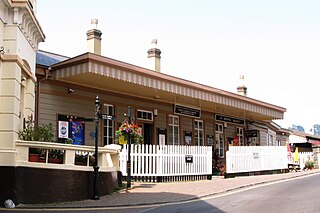
The Dartmouth and Torbay Railway was a broad gauge railway linking the South Devon Railway branch at Torquay with Kingswear in Devon, England. It was operated from the outset by the South Devon Railway.
The Torbay and Brixham Railway was a 7 ft broad gauge railway in England which linked the Dartmouth and Torbay Railway at Churston railway station, Devon with the important fishing port of Brixham. It was a little over two miles long. Never more than a local branch line, it closed in 1963.

The Cornish Riviera Express is a British express passenger train that has run between London Paddington and Penzance in Cornwall since 1904. Introduced by the Great Western Railway, the name Cornish Riviera Express has been applied to the late morning express train from London to Penzance continuously through nationalisation under British Rail and privatisation under First Great Western, only ceasing briefly during the two World Wars. The name is also applied to the late morning express train running in the opposite direction from Penzance to London. Through performance and publicity the Cornish Riviera Express has become one of the most famous named trains in the United Kingdom and is particularly renowned for the publicity employed by the Great Western Railway in the 1930s which elevated it to iconic status. Today it is operated by the Great Western Railway train operating company.
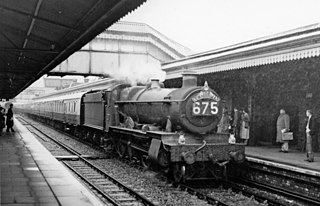
The Cornishman was a British express passenger train to Penzance in Cornwall. From its inception in the 19th century until before World War II it originated at London Paddington. Under British Railways the name was applied to a different service, starting variously from Wolverhampton, Leeds or Bradford.
The Langport and Castle Cary Railway is a railway line from Castle Cary railway station to Cogload Junction near Taunton, Somerset, England, which reduced the length of the journey from London to Penzance by 20+1⁄4 miles (32.6 km).






















